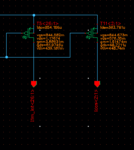prcken
Advanced Member level 1

- Joined
- Nov 1, 2006
- Messages
- 419
- Helped
- 41
- Reputation
- 82
- Reaction score
- 38
- Trophy points
- 1,308
- Location
- Shanghai
- Activity points
- 4,059
Hi,
I am wondering in the layout for high speed (> 10 GHz) differential signal, what's the spacing is reasonable? the signals will deteriorated a lot by the mutual capacitance?
Another question about the layout of a bus of current sources in the chip (schematic shown below), for example, i have more than 20 current sources go to different places on chip, should I use ground shielding for the currents?

Thanks!
I am wondering in the layout for high speed (> 10 GHz) differential signal, what's the spacing is reasonable? the signals will deteriorated a lot by the mutual capacitance?
Another question about the layout of a bus of current sources in the chip (schematic shown below), for example, i have more than 20 current sources go to different places on chip, should I use ground shielding for the currents?

Thanks!

